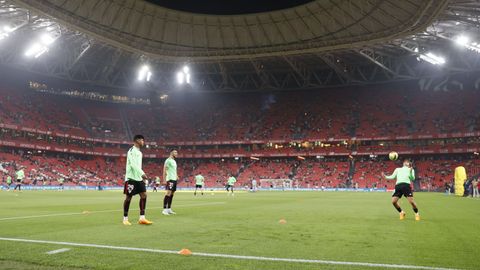
Author: Louis Fabric | EFE
LaLiga presents economic report for season 21-22 and highlights “success and strength of model based on financial sustainability”
Spanish professional clubs they have practically returned to pre-pandemic income levels and they recorded the least total losses in big football Europe. This is indicated by the economic report on the 21-22 season presented this Thursday by LaLiga, an organization that highlights “the success and solidity of a model based on financial sustainability”.
The total income was HRK 4,838 millionagain reaching the maximum historical level of the season 19-20, after the sharp contraction of the academic year 21-22, which reduced this figure to below 4,000 million and which has now reached a significant annual growth of 22.6%.
Logically, the biggest growth was experienced by the ‘matchday’ game, with an increase of 123% due to the general return of the crowd to the stadiums and the lifting of capacity restrictions during the first part of the season. There was also a significant increase in commercial revenues (+2.9%) in a difficult economic context, which compensated for part of the loss of revenues from the previous year as a result of the pandemic.
With these numbers, LaLiga again wins the second position in the higher league, both in absolute and relative terms, measuring income per inhabitant and at the same price level. In this sense, the return of first place in relative terms will happen naturally during the coming seasons, when pre-Covid activity returns to the player transfer market, which has been reduced in Spain.
Wage costs are falling
In total expenses, the largest item is still the costs of sports personnel with 47%, although the weight of salary expenses in relation to the Net Business Figure (INCN) fell from 81.2% to 75.1%, and in relation to total income from 61.4 % to 54.5%. According to LaLiga, this “shows the efforts that clubs are making to contain costs, with the aim of optimizing their operational efficiency and improving their financial situation.”
The Spanish competition’s overall net result was still a loss of 140 million in 21-22, but with a deficit level reportedly lower than that of the previous year, and also that of the other major leagues. The Bundesliga in Germany suffered a drop of 205 million, the LFP in France 601, the Premier League and the Championship around -1.005 million, and for Series A and B approximately losses of 1.150 million According to Javier Tebas, president of La Liga, these data “came to confirm a sustainable model LaLiga and Bundesliga, in contrast to other models based on the lack of adequate economic control and on the constant losses of their clubs, which are financed by systematic and huge contributions of resources from their shareholders, i.e. say, undeniable financial doping that changes the rules of ‘fair play’ and spoils the competition”.
The total EBITDA of the Spanish competition, both before and after the results for player transfers, was again in the positive, with 23.9 million and 280.8 million respectively. This is important progress, but still far from the annual records achieved before the pandemic.
In this sense, it is important to point out that however, it will take several years to overcome the long-term negative effects resulting from this health crisis in full, the situation is shared by all European reference competitions, although the global situation of LaLiga is particularly favorable in a comparative sense.
The evolution of activity on the player market is probably the clearest indicator of this situation in professional football. Lower activity in the player market has a strong impact on the selling price of transfers. (removal of players), but the “automatic stabilizers” activated by LaLiga cause the adjustment to be largely carried out at the pace of purchase prices for transfers (registration of players), effectively protecting the balance sheet and financial physiognomy of players, clubs.
Favorable evolution
This favorable evolution also allowed the competition’s total organic operating cash flow (before net investment in infrastructure) to return to positive, at 104.3 million, for the first time since the 18-19 season. As a result, the net debt increased by barely 0.8% compared to the previous year and amounts to HRK 2,102.4 million.
It should be noted that the positive aggregate records of Ebitda and organic operating cash flow do not take into account the hundreds of millions in profits and extraordinary financial resources that Real Madrid and Barcelona received as a result of their corporate asset monetization or futures rights sales operations.
Total net investment is rising again thanks to increased investments in infrastructure, with important actions in stadiums and sports cities. It is expected to continue to increase thanks to the entry into maturity of the Impulse Plan investment and other relevant comprehensive renovations such as the Spotify Camp Nou and the Santiago Bernabéu.
As for the forecasts for the current season 22-23, it is estimated that the growth of income will gradually continue and, most importantly, that the total net profit will be registered again in the Spanish professional competition.
Source: La Vozde Galicia
I’m Emma Jack, a news website author at 24 News Reporters. I have been in the industry for over five years and it has been an incredible journey so far. I specialize in sports reporting and am highly knowledgeable about the latest trends and developments in this field.







